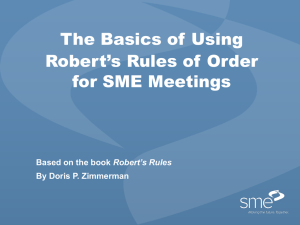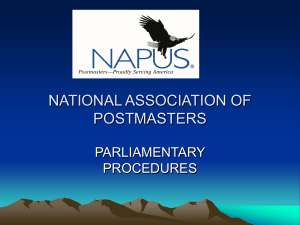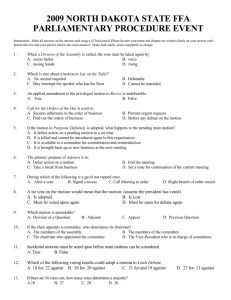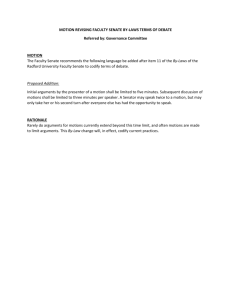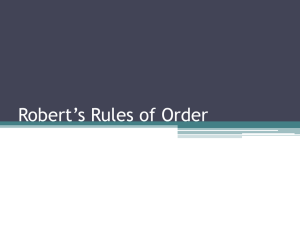Basic Parliamentary Procedure: A Quick Guide
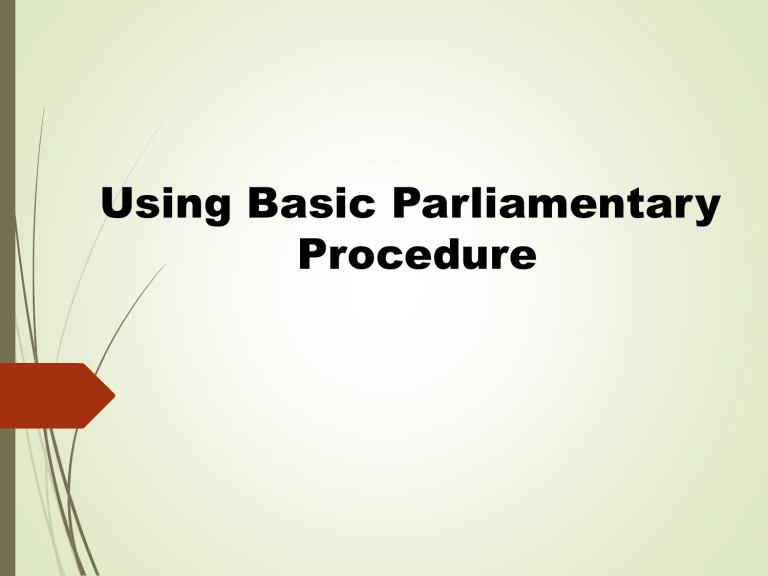
Using Basic Parliamentary
Procedure
Reference &Disclaimer
This presentation is based on Robert’s
Rules of Order, newly revised.
What is Parliamentary Procedure?
Rules that limit, guide and protect the individual
Protect the rights of the minority
It’s not that the decision you make must be correct, but each decision you make must be correctly made.
Why do we use Parliamentary
Procedure?
To facilitate the transaction of business
To promote cooperation and harmony
To ensure that all members have equal rights, privileges, and obligations
Ensure the majority has the right to decide, but the minority has rights which must be protected as well
Basic Principles
A quorum must be present for the group to act.
As defined by the by-laws
If not, then majority of membership
Only one question should be considered at any given time.
No member should speak until recognized by the chair.
The chair should maintain strict impartiality during discussion.
Chair can vote if it will affect the outcome
Quorum
Quorum is minimum number of members necessary to conduct business (present throughout meeting)
Quorum should be determined by bylaws
For all meetings – regular, special, annual, etc
Otherwise, it is majority of entire membership
If quorum ceases to exist during meeting:
Only motions in order are:
To recess until quorum returns
Motion to adjourn
Procedure for Handling Main
Motions
Member rises and addresses the Chair.
“Madam President”
President recognizes the member.
Member states:
“I move that _______ (states motion).”
Second to motion (not necessary to stand or be recognized).
“I second the motion.”
Procedure for Handling Main
Motions
President states motion:
“It has been moved by (name) and seconded that _________.”
Discussion:
If debatable, every member has right to debate
President refrains from debate while presiding
Proposer of motion has first right of debate
Must be related (germane) only to motion
President says:
“If there is no further discussion, the motion is
_______(restate motion).”
Procedure for Handling Main
Motions
Vote:
The President says, “All those in favor of ______(the motion is stated) say ‘aye.’ Those opposed say ‘no.’
If motion requires 2/3 vote, ask for rising or by show of hands.
Should always ask for those opposed.
Result of the vote is stated by the
President .
“The motion is carried” or “the motion is lost.”
Rules of Debate
President begins debate by asking for discussion
Maker of motion has right to speak first, if properly recognized
Can only speak twice on same motion during the same meeting
Any motion that stops or limits debate requires a 2/3 vote
Tie Vote
A tie vote is a failed vote
President does not have to break a tie unless specified in bylaws
President can vote to make or break a tie vote
Classes of Motions
Main Motions
Motions That Bring a Question Again Before the Assembly
Incidental Motions
Subsidiary Motions
Privileged Motions
Order of Pending Motions
Privileged Motions
Subsidiary Motions
Incidental Motions (non-ranked)
Motions That Bring a Question Again Before the Assembly
Main Motions
Privileged Motions
Do not relate to pending business
Related to the rights and privileges to the assembly or to its members
Not Debatable
Privileged Motions
To fix the time to which to adjourn
To adjourn
To Recess
To rise to a question of privilege
To call for the order of the day
Subsidiary Motions
Assisting in treating or disposing of a main motion
All require second
Debatable: Depends
Requires majority vote unless involving rights of others
Call for previous question (2/3)
Limit or extend of debate (2/3)
Most widely used is “Amend”
Subsidiary Motions
To lay on the table
To call for the previous question
To limit or extend debate
To postpone to a definite time
To refer to a committee
To amend
To postpone indefinitely
Incidental Motions
Incidental to pending motions or business at hand
Not debatable
Incidental Motions
To suspend the rules
To withdraw a motion
To call for reading of papers
To object to consideration
To rise to a point of order
To rise to a parliamentary inquiry
To appeal from the decision of the Chair
To call for a division of the house
To call for a division of the question
Motions That Bring a Question
Again Before the House
Brings back to the assembly a question that has already been considered
Requires a second
May or may not be debatable
Take from table, non-debatable
Motions That Bring a Question
Again Before the House
To reconsider
To rescind
To take from the table
Commonly Used Motions
Main Motion
Motion to Amend
Call for the Question
Call for the Division of the House
Refer to a Committee
To lay on the Table
Withdraw a Motion
Rise to a Point of Order
Adjourn
Main Motion
Brings before the assembly a question or business consideration
In order only when no other motion is pending
Only one main motion on the floor at any time
Requires second, debatable, usually approved by majority vote
Amendments
Only two amendments can be pending at any one time
Primary
Applied to Main Motion
Secondary
Applied to primary amendment
Can have infinite number of secondary amendments as long as only two total amendments pending at any one time
Vote on amendments in reverse order
Secondary then primary
Amending a Motion
Most used Subsidiary Motion
Methods of Amending
Insert (inside the motion)
Add (at the end)
Strike out
Strike out and insert (words only)
Substitute (a paragraph)
Must be germane to main motion
“Question or Call for the Question”
Actual motion is “Call the Previous Question”
Must be recognized by chair to make motion, cannot be just shouted out
Is a vote to stop debate and not to vote on pending motion
Requires a 2/3 vote to pass
2/3 votes are taken by counted vote
If it receives 2/3 vote, motion passes and debate is stopped and a vote is taken immediately on pending question
If does not receive 2/3 vote, motion fails and debate continues
Call for the Division of Assembly
Questions results of a vote
Only in order if a questionable vote
Can be made by a single member
Can interrupt a speaker
Is not debatable
Does not require a vote
Made by a counted vote
Refer to Committee
Allows for additional information or study of issue before voting
Motion to Refer should include details of who the committee will be and who will appoint
Usually defines time for committee to report
Tabling a Motion
Proper form of motion is to “Lay on Table”
Misuse of “Postpone Indefinitely” or
“Postpone to a Definite Time”
Intention sometimes is “Refer” or
“Commit” which sends to committee for further review
Out of order when no business is pending
Withdraw a Motion
Motion can be withdrawn at any time prior to voting
Before restated by President belongs to maker
Can be withdrawn, changed or modified in any way with only approval of maker
After restating, belongs to assembly
Maker asks permission to withdraw
President treats first as unanimous-consent request
If objection, treated as a subsidiary motion
Rise to a Point of Order
Used to correct a mistake in procedure
Can interrupt a speaker
Doesn’t require a second
Is not debatable
Chair rules
Must be raised at time of mistake before action has been taken
Adjourn
Can not interrupt a speaker
Requires a second
Not debatable
Majority rules
Chair can adjourn without motion
If no other business is pending
Motions Requiring 2/3 Vote
Suspends or modifies Rules of Order
Closes, limits or extends debate
Limits freedom of nominations or voting
Takes away membership or office
Out of Order Motions
Motion to suspend bylaws
Motion in conflict with bylaws or Articles of
Incorporation
Any motion outside the scope of the organization
“The purpose of this organization is ….”
Any motion to conduct business if quorum is not present, except motion to recess or adjourn
Minutes
• Only record what was done, not everything that was said
• Corrected at any time mistake is discovered, even years later
• Good minutes are first line of defense in appeals
Order of Business vs. Agenda
Order of Business
Basic outline of business proceedings
Agenda
Schedule of the order of business, with details
Should not be confused with Rules of Order
Order of Business
Call to order
Reading and approval of the minutes
Reports of Special Committees
Special Orders (matters which demand special priority)
Unfinished/Old Business
New Business
Agenda
Call to Order
Opening Ceremonies (Prayer, Objective, etc)
Roll Call
Reading and Approval of the Minutes
Report of Officers, Boards and Committees
Unfinished/Old Business
New Business
Announcements
Adjournment
